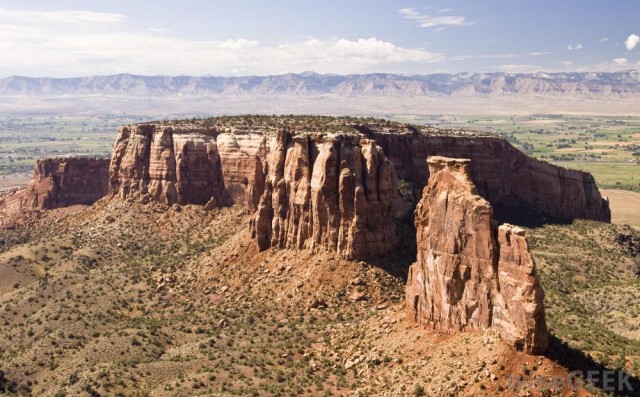plateau
A PLATEAU IS A LARGE area of mostly level land elevated high above the surrounding land. Most plateaus have one steeply cliffed side. The rock layers in a plateau are un-deformed and remain flat, unlike the rock layers in mountains, which are tilted. Basaltic plateaus are formed when molten rock forces its way up through a fissure, or crack, in the Earth's surface. The molten material flows out slowly, blanketing a large area with a thick layer of lava. When the lava cools, it forms a dark gray rock called basalt. In order for a plateau to form, the area needs to be uplifted slowly so that all layers are folded to make a flat top.
Plateaus can also be formed when plates of the Earth's crust collide. This causes the crust to buckle. Mountains may be formed, but in the area behind the collision area, a plateau is often created. Erosion can also cause a large flat surface of the Earth to uplift. If rivers cut deeply into the Earth, the area around it becomes raised above the surrounding land. Faults and erosion can divide a plateau into smaller plateaus. Also a plateau may be eroded into a smaller landform known as a mesa or a butte. Plateaus in humid areas can have many mountains, caused by erosion from rivers. Erosion can form canyons in a plateau when a river eats deeply into the Earth. The edges of plateaus on the shore can be shaped into peninsulas and bays by the action of the ocean waves.

Some well-known plateaus include the TIBETAN PLATEAU in Asia and the Colorado and Columbia plateaus in the UNITED STATES. Scientists believe that for the past 50 million years, since a collision between Asia and INDIA, the Tibetan Plateau has been forming. The plateau is the largest and highest plateau in the world. It measures about 2,175 mi (3,500 km) by 932 mi (1,500 km) and the average elevation is more than 16,400 ft (5,000 m). It is located next to the Himalayan Mountains.
The Columbia River Plateau in the northwestern United States formed when lava flowed from fissures in the earth's surface about 17 million years ago. The lava covered an area approximately 63,321 square mi
(164,000 square km) and in some places is about 11,483 ft (3,500 m) thick. The plateau covers parts of the states of WASHINGTON, OREGON, and IDAHO.
The Colorado River Plateau is made up of colorful sedimentary rocks formed millions of years ago when much of the western United States was covered by a vast ocean. The most spectacular feature of the Colorado Plateau is the GRAND CANYON, carved away by the Colorado River. Plateaus are formed in different ways and look different, but they all are relatively flat and are formed of unbroken layers of rock.